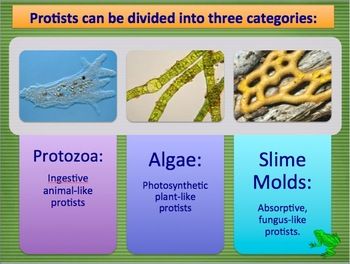are protists photosynthetic
Plastid is a general term for all such organelles including chloroplasts in the green lineage rhodoplasts in the red lineage leucoplasts colourless plastids etc Fig. As algae can be single-celled filamentous string-like or plant-like they are often difficult to classify.

Protista Kingdom Algae And Protozoa Powerpoint And Notes Protists Teaching Biology Science Teacher Resources
Because they need light phytoplankton live.

. The depth to which sunlight or artificial light can penetrate into water so that photosynthesis may occur is known as the photic zone. Photosynthetic protists such as the various types of algae contain plastids. But slime molds and water molds are fungus-like saprophytic protists although some are pathogens. Phytoplankton are made up of single-celled algae and cyanobacteria.
Autotroph definition any organism capable of self-nourishment by using inorganic materials as a source of nutrients and using photosynthesis or chemosynthesis as a source of energy as most plants and certain bacteria and protists. The International Code of Nomenclature for algae fungi and plants is the set of rules and recommendations that govern the scientific naming of all organisms traditionally treated as algae fungi or plants whether fossil or non-fossil including blue-green algae Cyanobacteria chytrids oomycetes slime moulds and photosynthetic protists with their taxonomically related non. Protists are a group of loosely connected. Many of these appear.
Plastids are the photosynthetic organelles of plants and algae. Photoautotrophic organisms are sometimes referred to as. Protists exhibit locomotion through cilia and flagella. Citation needed Cyanobacteria which.
Other protists such as euglena phytoplankton and bacteria such as cyanobacteria. Most organizations group algae by their primary color green red or brown though this creates. They are what is known as primary producers of the oceanthe organisms that form the base of the food chain. Mold Mold generally refer to fungi.
The sexual method of reproduction is extremely rare and occurs only during times of stress. Green plants and photosynthetic bacteria are photoautotrophs. These organisms can be further differentiated based on the pigment used in photosynthesis. A few organisms belonging to kingdom Protista have pseudopodia that help them to move.
Chlorophyll green algae fucoxanthin brown algae and phycoerythrin red algae among others. Kingdom Protista is classified into the. Some protists sometimes called ambiregnal protists have been considered to be both. These organelles serve as the site of photosynthesis the process of harvesting sunlight to produce nutrients in the.
Algae are sometimes considered protists while other times they are classified as plants or choromists. It is estimated that members of this group contribute to nearly 40 of the photosynthetic activity on earth. Like land plants they take up carbon dioxide make carbohydrates using light energy and release oxygen. Two separate types of slime molds exist the cellular and acellular forms.
Plastids have diverse functions in addition to photosynthesis including the biosynthesis of amino acids fatty acids and isoprenoids. The dinoflagellates diatoms and Euglena-like flagellates are photosynthetic protists. Phytoplankton are mostly microscopic single-celled photosynthetic organisms that live suspended in water. Protista reproduces by asexual means.

Euglena Cells Seem Like Plant And Animal Cells Protists Plant And Animal Cells Animal Cell

General Groups Of Protists Protists Life Science Lessons Science Teacher Resources

Protists Example Euglena Flagella Pigment Spot Or Stigma Positive Protists Biology Photosynthesis

Structure Function Reino Protista Membrana Celular Membrana

Difference Between Protists And Fungi Characteristics Classification Types Examples Study Biology Teaching Biology Biology Notes
Post a Comment for "are protists photosynthetic"